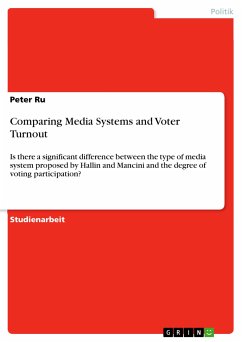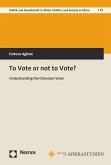Studienarbeit aus dem Jahr 2014 im Fachbereich Politik - Politische Systeme allgemein und im Vergleich, Note: 1,0, Universität Mannheim (Fakultät für Sozialwissenschaften), Veranstaltung: Seminar: Comparing Media Systems and Media Policies across Europe, Sprache: Deutsch, Abstract: This paper concentrates on the effects of media systems on voter turnout. It is based on the work of Hallin and Mancini “Comparing Media Systems: Three Models of Media and politics” published in 2004 (Hallin/Mancini 2004). Thus the research question this paper seeks to answer is “Is there a significant difference between the type of media system proposed by Hallin and Mancini and the degree of voting participation?” All three models differ in their size of media markets, their degree of political parallelism as well as the different kinds of professionalization of the journalists and the role of the state in the media systems. Subsequently there is a possibility of this affects the number of people attending elections. It is expected to find significant differences between the models in their degree of voting participation. In the following chapters this paper introduces the categorization of Hallin and Mancini and discusses its findings and also presents the reception of their work. Next the theory and the hypothesis are introduced. Then the methodology is displayed. Bivariate regression analysis will be used in order to analyse the differences regarding the media systems and the voter turnout. After that the findings of the analysis is shown and finally the conclusion drawn from the findings are discussed.








